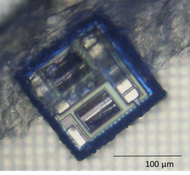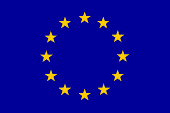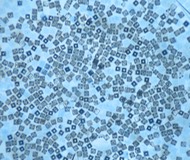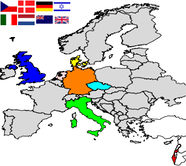The following requirements for a lablet cloning demonstration were established:
1. The fast and reagent free ligation chemistry via disulphide exchange reaction of oligonucleotides was invented in our group[i] and recently developed further to a pH-controllable ligation system via triplex ligation. The triplex motif was synthesized and successfully tested regarding its pH-dependency. The validity of this research for MICREAgents depends on electronic pH switching as a control tool for rapid disulphide DNA ligation in triplex structures [ii].
2. For the detection of the disulphide ligation process we have developed a FRET quenching method which allows an online detection in solution of the order of nanomolar concentrations in solution [i]. Recently we have further developed the detection method by the invention of a new quencher leaving group which lowers the detection limit by at least one order of magnitude.
3. As only low ODN quantities proved immobilizable on the lablet surface, the decoration of lablets or model surfaces with oligonucleotides, addressable for SPREAD amplification, stays the crucial point in WP4. Our previous efforts to utilize common immobilization methods (streptavidin-biotin, amine-aldehyde, gold-thiol) revealed problems with the reproducibility, the selectivity and the hybridization efficiency of oligonucleotides on nanoparticles or lablet gold surfaces. We observed a hybridization efficiency of up to 50% on streptavidin-biotin-ODN nanoparticles, for thiol- ODN on gold-nanoparticles a hybridization efficiency of 44% is described. Hence we now consider the oligonucleotide surface coverage on streptavidin- or gold-films as too low for an efficient DNA ligation and the detection thereof. Therefore, in the last period of the project we investigated the increase of the addressability of the lablet gold surface with a DNA-hydrogel modification.
[i] V. Patzke, J. S. McCaskill, G. von Kiedrowski, Angew. Chem. Int. Ed. (2014), 53(16), 4222-4226; Angew. Chem. (2014), 126(16), 4306–4310.
[ii] Minero, G. A. S.; Wagler, P. F.; Oughli, A. A.; McCaskill, J. S., RSC Advances 2015, 5(35), 27313-27325; 5(65), 52321.




